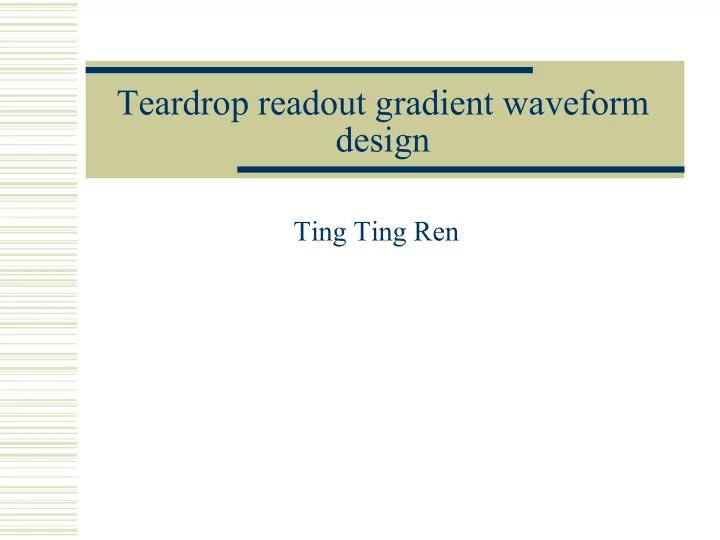

Teardrop readout gradient waveform design Ting Ting Ren
Overview � MRI Background � Teardrop Model � Discussion � Future work
MRI Background: Classical Description of MRI � Spins: MR – relevant nuclei, like 1 H. � Main Field B 0 : The magnetic moment vectors tend to align in the direction of B 0 to create a net magnetic moment, the nuclear spins exhibit resonance at the Larmor frequency. � Radio frequency (RF) field B 1 : applied in the xy plane to excite these spins out of equilibrium. � Gradient fields G: Phase encoding, frequency encoding
MRI Background: Linear Gradient fields G Square water object: (a) Given only B 0. (b)Given B 0 and linear gradient field. For 2D imaging, we need G x , G y .
MRI Background: Signal Equation and κ -Space � Signal Equation Where m(x, y) : the amplitude distribution of excited spins � The imaging problem becomes one of acquiring the appropriate set of signals { s(t) } to enable inversion of signal equation to determine m(x, y).
MRI Background: Signal Equation and κ -Space � Comparing the signal equation with the 2D Fourier transform of m(x, y), � The total recorded signal s(t) maps directly to a trajectory through Fourier transform space as determined by the time integrals of the applied gradient waveforms G x (t) and G y (t). � In MRI, 2D Fourier transform space is often called “ κ - Space ”, where κ represents the spatial frequency variable. � Proper image formation depends on the appropriate coverage in κ -Space .
MRI Background: Spatial Frequency Patterns and 2D Imaging Methods Radial Echo Planar Projection Imaging 2DFT Imaging Reconstruction
MRI Background: Spatial Frequency Patterns and 2D Imaging Methods Interleaved Square Spiral spiral spiral Resample Inverse FT •Fast Imaging : acquire a greater portion of к -space per signal readout. •The gradient system must be able to generate the trajectory.
Teardrop Model: The teardrop κ -Space trajectory � The teardrop gradient waveform is continuous family of waveforms, one extreme of which integrates to describe a teardrop shaped κ -Space trajectory. � It is designed to follow an interleaved spiral like trajectory leaving the center of К -Space, become tangent to a circle at the required resolution, and returning on the mirror image trajectory to the center of κ -Space .
Teardrop Model: Gradient Waveform The actual waveform is generated numerically and can be designed interactively to match requested TR and resolution.
Teardrop Model: Advantages of Teardrop � By using a non-raster trajectory beginning and ending in the center of κ -Space, a teardrop readout requires neither read nor phase dephase lobes, increasing scan time efficiency. � By resampling the center of κ -Space at the beginning of every shot, reconstruction can compensate for the approach to steady state, and the sequence is less sensitive to motion artifacts.
Teardrop Model: Discrete Model maximize s.t. where
Teardrop Model: The spiral constraints K = α 2 This constraint is meant to ensure that the trajectory is inside a standard spiral trajectory.
Teardrop Model: Discussion � Optimal version of teardrop waveform design. � Can add other constraints, like add velocity compensation constraint to model the effect of flowing velocity on the image . � Have demonstrated the feasibility of the technique.
Future Work � Formulate a new teardrop model using a series of LP problems to optimize the waveform. � Test the linear model by some linear solvers. � Compare results and quality with the original model. � Improve the model and apply interior point method to develop a fast and embeddable solver � Apply the technique to 3D imaging.
Recommend
More recommend